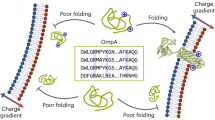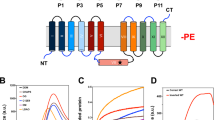Abstract
Dimerization is a biological regulatory mechanism employed by both soluble and membrane proteins1. However, there are few structural data on the factors that govern dimerization of membrane proteins. Outer membrane phospholipase A (OMPLA) is an integral membrane enzyme which participates in secretion of colicins in Escherichia coli. In Campilobacter2 and Helicobacter pylori strains3, OMPLA is implied in virulence. Its activity is regulated by reversible dimerization4,5. Here we report X-ray structures of monomeric and dimeric OMPLA from E. coli. Dimer interactions occur almost exclusively in the apolar membrane-embedded parts, with two hydrogen bonds within the hydrophobic membrane area being key interactions. Dimerization results in functional oxyanion holes and substrate-binding pockets, which are absent in monomeric OMPLA. These results provide a detailed view of activation by dimerization of a membrane protein.
This is a preview of subscription content, access via your institution
Access options
Subscribe to this journal
Receive 51 print issues and online access
$199.00 per year
only $3.90 per issue
Buy this article
- Purchase on Springer Link
- Instant access to full article PDF
Prices may be subject to local taxes which are calculated during checkout



Similar content being viewed by others
References
Klemm, J. D., Schreiber, S. L. & Crabtree, G. R. Dimerization as a regulatory mechanism in signal transduction. Annu. Rev. Immunol. 16, 569–592 (1998).
Grant, K. A., Ubarretxena-Belandia, I., Dekker, N., Richardson, P. T. & Park, S. F. Molecular characterization of pldA, the structural gene for a phospholipase A from Campylobacter coli, and its contribution to cell-associated hemolysis. Infect. Immun. 65, 569–592 (1997).
Bukholm, G. et al. Colony variation of Helicobacter pylori: pathogenic potential is correlated to cell wall lipid composition. Scan. J. Gastroenterol. 32, 569–592 (1997).
Dekker, N., Tommassen, J., Lustig, A., Rosenbusch, J. P. & Verheij, H. M. Dimerization regulates the enzymatic activity of Escherichia coli outer membrane phospholipase A. J. Biol. Chem. 272, 569–592 (1997).
Dekker, N., Tommassen, J. & Verheij, H. M. Bacteriocin release protein triggers dimerization of outer membrane phospholipase A in vivo. J. Bacteriol. 181, 569–592 (1999).
Merck, K. B., de Cock, H., Verheij, H. M. & Tommassen, J. Topology of the outer membrane phospholipase A of Salmonella typhimurium. J. Bacteriol. 179, 569–592 (1997).
Weiss, M. S. et al. Molecular architecture and electrostatic properties of a bacterial porin. Science 254, 569–592 (1991).
Schirmer, T., Keller, T. A., Wang, Y.-F. & Rosenbusch, J. P. Structural basis for sugar translocation through maltoporin channels at 3.1 Å resolution. Science 267, 569–592 (1995).
Pautsch, A. & Schulz, G. E. Structure of the outer membrane protein A transmembrane domain. Nature Struct. Biol. 5, 569–592 (1998).
Locher, K. P. et al. Transmembrane signaling across the ligand-gated FhuA receptor: Crystal structures of free and ferrichrome-bound states reveal allosteric changes. Cell 95, 569–592 (1998).
Buchanan, S. K. et al. Crystal structure of the outer membrane active transporter FepA from Escherichia coli. Nature Struct. Biol. 6, 569–592 (1999).
Horrevoets, A. J., Verheij, H. M. & de Haas, G. H. Inactivation of Escherichia coli outer-membrane phospholipase A by the affinity label hexadecanesulfonyl fluoride. Evidence for an active-site serine. Eur. J. Biochem. 198, 569–592 (1991).
Brok, R. G. P. M., Dekker, N., Gerrits, N., Verheij, H. M. & Tommassen, J. A conserved histidine residue of Escherichia coli outer-membrane phospholipase A is important for activity. Eur. J. Biochem. 234, 569–592 (1995).
Brok, R. G. P. M., Ubarretxena-Belandia, I., Dekker, N., Tommassen, J. & Verheij, H. M. Escherichia coli outer membrane phospholipase A: Role of two serines in enzymatic activity. Biochemistry 35, 569–592 (1996).
Dodson, G. & Wlodawer, A. Catalytic triads and their relatives. Trends Biochem. Sci. 23, 569–592 (1998).
Ubarretxena-Belandia, I., Boots, J. W. P., Verheij, H. M. & Dekker, N. Role of the cofactor calcium in the activation of outer membrane phosphilipase A. Biochemistry 37, 569–592 (1998).
Horrevoets, A. J. G., Hackeng, T. M., Verheij, H. M., Dijkman, R. & De Haas, G. H. Kinetic characterization of Escherichia coli outer membrane phospholipase A using mixed detergent-lipid micelles. Biochemistry 28, 569–592 (1989).
Wei, Y. et al. A novel variant of the catalytic triad in the Streptomyces scabies esterase. Nature Struct. Biol. 2, 569–592 (1995).
Ubarretxena-Belandia, I. et al. Outer membrane phospholipase A is dimeric in phospholipid bilayers: A cross-linking and fluorescence resonance energy transfer study. Biochemistry 38, 569–592 (1999).
Blaauw, M., Dekker, N., Verheij, H. M., Kalk, K. H. & Dijkstra, B. W. Crystallization and preliminary X-ray analysis of outer membrane phospholipase A from Escherichia coli. FEBS Lett. 373, 569–592 (1995).
Otwinowski, Z. & Minor, W. Processing of X-ray diffraction data collected in oscillation mode. Methods Enzymol. 276, 569–592 (1997).
Kabsch, W. Automatic processing of rotation diffraction data from crystals of initially unknown symmetry and cell constants. J. Appl. Crystallogr. 26, 569–592 (1993).
Collaborative Computational Project Number 4. The CCP4 suite: programs for protein crystallography. Acta Crystallogr. D 50, 569–592 (1994).
Brünger, A. T. Free R value: a novel statistical quantity for assessing the accuracy of structures. Nature 355, 569–592 (1992).
Jones, T. A., Zou, J.-Y., Cowan, S. W. & Kjeldgaard, M. Improved methods for building protein models in electron density maps and the location of errors in these models. Acta Crystallogr. A 47, 569–592 (1991).
Kraulis, P. J. MOLSCRIPT: a program to produce both detailed and schematic plots of protein structures. J. Appl. Crystallogr. 24, 569–592 (1991).
Merritt, E. A. & Bacon, J. A. Raster3D: photorealistic molecular graphics. Methods Enzymol. 277, 569–592 (1997).
Nicholls, A., Sharp, K. A. & Honig, B. Protein folding and association: insights from the interfacial and thermodynamic properties of hydrocarbons. Proteins Struct. Funct. Genet. 11, 569–592 (1991).
Esnouf, R. M. An extensively modified version of Molscript that includes greatly enhanced coloring capabilities. J. Mol. Graphics 15, 569–592 (1997).
Acknowledgements
We thank the staff at the EMBL-outstation at DESY in Hamburg, and at the D2AM and the ID2B beam lines at ESRF Grenoble, for assistance with data collection. We thank R. L. Kingma for her enthusiastic collaboration and discussions. We thank the ESRF for supporting the work at the ESRF. These investigations were supported by the Netherlands Foundation for Chemical Research (CW) with financial aid from the Netherlands Organization for Scientific Research (NWO). We thank the EU for supporting the work at EMBL Hamburg through the HCMP Access to Large Installations Project.
Author information
Authors and Affiliations
Rights and permissions
About this article
Cite this article
Snijder, H., Ubarretxena-Belandia, I., Blaauw, M. et al. Structural evidence for dimerization-regulated activation of an integral membrane phospholipase. Nature 401, 717–721 (1999). https://doi.org/10.1038/401717a0
Received:
Accepted:
Issue Date:
DOI: https://doi.org/10.1038/401717a0
This article is cited by
-
Mechanism of outer membrane destabilization by global reduction of protein content
Nature Communications (2023)
-
Evidence for phospholipid export from the bacterial inner membrane by the Mla ABC transport system
Nature Microbiology (2019)
-
Outer membrane phospholipase A’s roles in Helicobacter pylori acid adaptation
Gut Pathogens (2017)
-
Outer membrane protein folding from an energy landscape perspective
BMC Biology (2017)
-
Structural basis for maintenance of bacterial outer membrane lipid asymmetry
Nature Microbiology (2017)
Comments
By submitting a comment you agree to abide by our Terms and Community Guidelines. If you find something abusive or that does not comply with our terms or guidelines please flag it as inappropriate.



